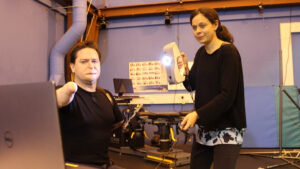
A project underway at the University of Bath could make socket fitting and rehabilitation faster for new users of prosthetic limbs. Researchers are developing technology that gives patients or their caregivers the ability to photograph their residual limbs using a mobile phone or digital camera that replicates the results clinicians can get with high-end 3D scanners. The images, captured remotely, would decrease patients’ trips to the hospital or clinic while still addressing frequent changes to the residual limb, and at a fraction of the cost.
The collaborative project is being led by Nicola Bailey, PhD, in Bath University’s Department of Mechanical Engineering, and Elena Seminati, PhD, in the university’s Department for Health. Seminati has led work improving support for people with amputations over several years, including with the Centre for the Analysis of Motion Capture.
“For amputees, each socket needs to be personalized, so it fits the shape of the residual limb, and it has to be designed quickly so that patients are able to get back to a relatively normal life as soon as possible,” she said.
Alex Lewis, who has quadrilateral amputations, is working on the project. “My hope through this work is that we can cut the time period down to give patients a much better outcome,” he said. “For me, the socket fit… took between four and five weeks to get right. For an amputee though, you want to be wearing this prosthetic as soon as possible, to be able to regain your independence. It just took a long, long time and lots of interactions. It was a long and labored process.”
“Through this work we want to find ways to speed up this process so as to improve rehabilitation for patients,” said Bailey. “There is a huge potential for impact through this project. The numbers of people with amputations worldwide is growing, and we know they can face serious physical and psychosocial disabilities which compromise their quality of life.”
To watch a video about the project, “Remote capture for patient data for bespoke socket design,” visit the University of Bath.
Editor’s note: This story was adapted from materials provided by the University of Bath.




